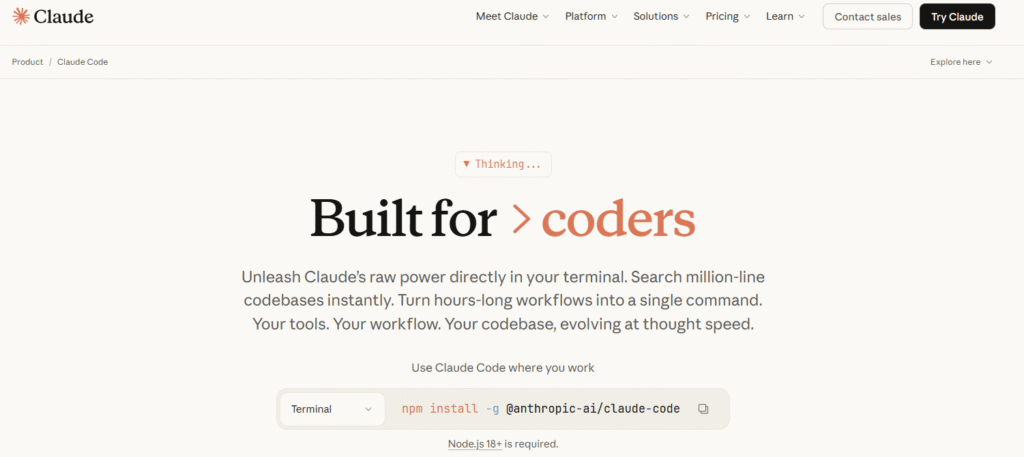You’re facing a mountain of code, deadlines are looming, and you need more than just caffeine to power through. Enter Claude Code vs Cursor – two revolutionary AI tools promising to transform how we write software.
But which one deserves a permanent spot in your development toolkit? This isn’t just another tech comparison; it’s about finding the perfect coding partner that matches your workflow, personality, and project needs.
Whether you’re a terminal wizard or an IDE enthusiast, understanding the Claude Code vs Cursor dynamic could be the difference between struggling with code and commanding it.
What is Claude Code?

Claude Code feels less like a traditional coding tool and more like hiring an exceptionally talented junior developer who never sleeps. Created by Anthropic, this terminal-based marvel operates through simple text commands while delivering sophisticated coding capabilities.
Instead of clicking through menus or navigating visual interfaces, you’re having a conversation with your codebase. You tell Claude Code what you want to accomplish, and it figures out the how – planning the approach, writing the code, testing changes, and even fixing its own mistakes along the way.
Claude Code Pros:
- Exceptional accuracy and code quality: Leverages deep reasoning capabilities and large context windows for high-fidelity code modifications and complex refactoring
- Seamless automation integration: Command-line nature makes it perfect for scripting and incorporating into existing CI/CD pipelines
- Superior large-scale project handling: Effectively reasons across massive codebases and executes multi-file changes without losing context
- Lightweight and responsive: Minimal overhead compared to full IDEs, providing snappy performance for focused coding tasks
Claude Code Cons:
- CLI-exclusive interface: No graphical environment requires strong terminal proficiency and presents a steeper learning curve
- Technical setup requirements: Command-line workflow demands configuration expertise that can challenge beginners
- Limited visual feedback: Absence of graphical cues makes tracking progress during complex operations challenging
- Inefficient micro-edits: Small manual adjustments often require re-prompting the AI or switching to traditional editors
Related Reading: Claude Code 2.0 Launches
What is Cursor?

Cursor takes the familiar Visual Studio Code environment and injects it with AI superpowers. If you’ve ever wished your IDE could read your mind, Cursor comes pretty close. It maintains everything you love about VS Code while adding intelligent features that feel like they’re from the future.
The AI assistance is woven throughout the editing experience – from inline code completions that anticipate your next move to file-level transformations that happen with a simple chat command.
Cursor Pros:
- Intuitive user experience: Visual interface with clear diffs and familiar VS Code layout ensures easy onboarding
- Zero learning curve for VS Code users: Maintains existing workflows while adding AI capabilities seamlessly
- Rapid prototyping and debugging: Real-time feedback and visual context enable incredibly fast iteration and issue resolution
- Enhanced collaborative coding: Interactive in-editor assistance creates a genuine pair-programming experience
Cursor Cons:
- Limited advanced control: Visual interface can restrict fine-grained control needed for complex system-level operations
- Occasional interface clutter: High density of AI features sometimes leads to visual noise or minor UI issues
- Higher resource consumption: Built on full IDE architecture naturally demands more system resources
- Context management requirements: Very large projects may need manual context handling to maintain optimal performance
Claude Code vs Cursor: Core Features Comparison
1. User Interface and Development Workflow
The interface difference between these tools represents a fundamental philosophical split in how developers should interact with AI.
Cursor wraps AI assistance around your existing habits. You’re still clicking through files in the explorer, opening tabs, and using the integrated terminal. When you ask Cursor to make changes, they appear as clean, familiar diffs that you can review line by line. This approach keeps you firmly in control – you’re the pilot, and AI is your co-pilot. The experience feels natural because it builds on decades of IDE evolution rather than reinventing the wheel.
Claude Code demands that you embrace a new way of working. There’s no file explorer, no tabs, no visual feedback beyond the terminal output. You issue a command like “refactor the authentication system to use JWT tokens” and watch as Claude Code analyzes your codebase, creates a step-by-step plan, and executes it autonomously. You’re not writing code; you’re managing an intelligent agent that writes code for you. The mental shift is significant but incredibly powerful once you adapt.
2. Code Editing Philosophy and Safety
How these tools handle code changes reveals their different perspectives on developer-AI relationships.
Cursor believes in augmentation. You’re expected to remain actively involved in the coding process. The safety features are designed for this collaborative approach – every AI modification creates a checkpoint that you can instantly revert to if something goes wrong. The selective application of changes means you can accept the good parts of an AI suggestion while rejecting the questionable ones. It’s like having an incredibly thorough code reviewer built into your editor.
Claude Code operates on an agency model. Once you give a command, the AI takes full responsibility for implementation. This hands-off approach is both liberating and terrifying. You’re trusting the AI to make correct decisions across your entire codebase. While Claude Code is remarkably competent, the lack of fine-grained control means you need thorough testing and version control as safety nets. It’s perfect for well-defined tasks but can feel overkill for simple edits.
3. Model Selection and Flexibility
The AI models powering these tools significantly impact their capabilities and performance.
Cursor offers what I call the “model buffet” – access to virtually every major AI provider including OpenAI’s GPT-4, Anthropic’s Claude models, Google’s Gemini, and more. This flexibility is incredibly valuable because different models excel at different tasks. You might use Claude for complex reasoning, GPT for creative solutions, and faster models for simple completions. The auto-selection feature intelligently matches models to tasks, optimizing for both performance and cost.
Claude Code takes a focused approach, exclusively using Anthropic’s models. While this means missing out on other providers, it delivers remarkable consistency. Anthropic has optimized their models specifically for the autonomous coding workflow that Claude Code enables. You spend less time deciding which model to use and more time getting work done. The simplicity is refreshing in a world of endless options.
Conclusion on Claude Code vs Cursor
So where does the claude code vs cursor debate leave us? These tools represent two valid but different visions for the future of AI-assisted development.
Claude Code is your autonomous coding agent, perfect when you need to tackle large-scale refactoring, manage complex multi-file changes, or work primarily in terminal-based environments. It excels when you want to describe what needs to be done and let the AI handle the implementation details. The learning curve is steeper, but the payoff in productivity for suitable tasks is tremendous.
Cursor is your AI-powered co-pilot, ideal for developers who want to remain hands-on with their code while benefiting from intelligent assistance. It shines for rapid prototyping, debugging, and projects where you need the flexibility to switch between manual coding and AI help. The familiar environment and model flexibility make it accessible to virtually any developer.
The truth is, many developers will eventually want both tools in their arsenal. Use Claude Code for heavy lifting and autonomous tasks, and Cursor for interactive development and quick iterations. The Claude Code vs Cursor decision isn’t about finding one winner, but about understanding which tool serves your current needs – or recognizing that having both might be the ultimate power move.



